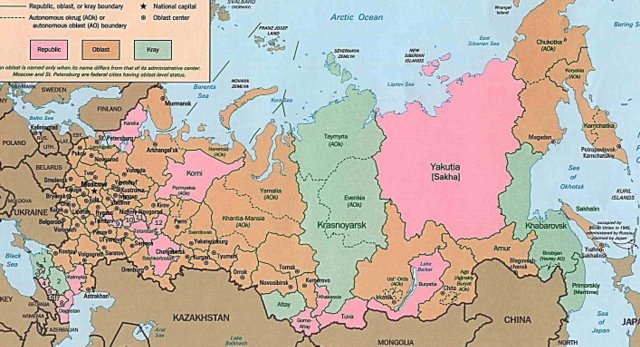The Samoyedic peoples
Samoyedic peoples include the Nenets, the Enets, the Nganasan, and the Selkups. The Samoyedic languages derive from a common ancestral language and together with the Finno-Ugric languages, to whom they are related, they form the Uralic language family.
On the Taymur Peninsula the Nganasans, who are the northernmost Samoyedic people, share their territory with the Dolgans. Their neighbours are the Yakut in the southeast and the Enets in the southwest. The Nganasans are few in number - 834 according to the 2002 Census. They are nomadic hunters, fishers and reindeer herders.
Like the Enets, the Nganasan have been demoralized by the loss of their culture, and alcoholism is a problem. This loss of culture followed campaigns in the 1940s to do away with shamanism and in the 1960s to make the Nganasan give up their nomadic life and settle in villages living alongside Russians and Dolgans.
In the 1930s the Nganasans still led a traditional life. Their main occupations were fishing and hunting and they often cooperated with the Enets in the hunt. Reindeer meat and fish were the staple food and they kept a small number of domesticated reindeer and dogs for transport purposes. The Nganasan lived in chums, conical tents covered with hides.
The 1930s brought big changes. So-called “red chums” for ideological instruction appeared and young communists were encouraged to go and help the northern peoples build a communist society. The anti-illiteracy campaign reached Taymyr and like elsewhere in the Soviet Union children of nomadic families were placed in boarding schools. Today, reindeer and pastures are owned by collective farms and the Nganasans have settled down into villages.
Tubyaku Kosterkin (1921-1989) was a Nganasan shaman. The Russian ethnologist Andrei Popov published his first book about Nganasans in 1936. The book contains a lot of information about Nganasan shamanism which Popov obtained from Tubyaku Kosterkin’s father, Dyukhade. This research is quoted by many anthropologists writing about shamanism. Tubyaku's father was not the first shaman in the Kosterkin family. According to a legend told to A. Popov, there was a wolf-tailed shaman among Dyukhade's ancestors. "A wolf began to kill reindeer. Nobody could catch it. At last a shaman said: "I'll get hold of it. The wolf, like other animals, does also have its mother." He shamanised three days running, then said: "I put the wolf into my wife, you'll see what kind of child will be born." A wolf-tailed child - the grandfather of Dyukhade - was born. He became a great shaman and lived all his life with the tail." For many years Tubyaku lived in the tundra as a hunter, fisherman, reindeer breeder, and a practising shaman. At the end of the 1940s Tubyaku was imprisoned by the Soviet authorities and indicted for accepting fees for his shamanist activities. After being released from prison in the 1950s he continued to shamanise[9].
Among the other Samoyedic peoples are the Selkups, who live in northern parts of Tomsk Oblast, Krasnoyarsk Krai, and in Tyumenskaya Oblast. Traditionally the Selkups are hunters, fishers and reindeer breeders. According to the 2002 census, there were 4,249 Selkups in Russia.
The Samoyedes were known for their Bjelkiers, a white working dog that could hunt, haul and herd reindeer. When the Russians began exploring Siberia they recognized the qualities the Bjelkier and used the dogs to pull sleds. Fridtjof Nansen also used the dogs on some of his Arctic expeditions as did another Norwegian explorer, Amundsen. The reputation among explorers soon got around and the breed became known in England thanks to Mr. Ernest Kilburn-Scott of the Royal Zoological Society. Kilburn-Scott accompanied an expedition to Archangel in the 1880's. He brought back a puppy to England where it attracted a lot of interest. Kilburn-Scott bought more dogs and showed them in several expositions. He founded the Samoyede Club and in 1909, Samoyede became the official name of the Bjelkier outside of Siberia.
The Dolgans
The Dolgans are a mix of Evenk, Yakut, Enets and Russians who migrated to the Taymyr region. They speak a Turkic language closely related to Yakut and number around 7,000, the majority of whom live on the Taymyr Peninsula. Ancestors of the Dolgans migrated from the banks of the River Lena at the end of the 17th century. One of the reasons for this migration was the fact that Russian goods, flour, for instance, arrived to the Taimyr Peninsula by boat. The Dolgans became an independent ethnic group during the last century. Most Dolgans are Russian Orthodox.
Traditionally they were nomadic reindeer breeders and hunters, and they also sold furs of polar foxes. They moved north in summer to avoid flies and mosquitoes. They moved over the tundra on wide skis and by dog-sleighs, and also rode reindeer. Like the Nganasan they were forced to settle in villages during Soviet times. However, some still lead a nomadic lifestyle.
The Italian journalist and photographer Livia Monami spent some months with the Dolgans living east of the Taymyr Peninsula in Sakha Republic. Monami reports that the Dolgans live in ‘baloks’ , or small wooden houses with runneres that can be pulled by reindeer. She says they leave the tundra in winter and come down south closer to the taiga where they can find fuel. They keep reindeer and their diet consists of cooked reindeer meat, liver and kidney, bread, and fish. Monami notes that her hosts have to travel six hours each way in a reindeer sleigh in temperatures reaching -50C to find fire wood. Another three hour journey is undertaken to find water in frozen lakes where the reindeer have not stirred up the mud so that the water is clean[10].
